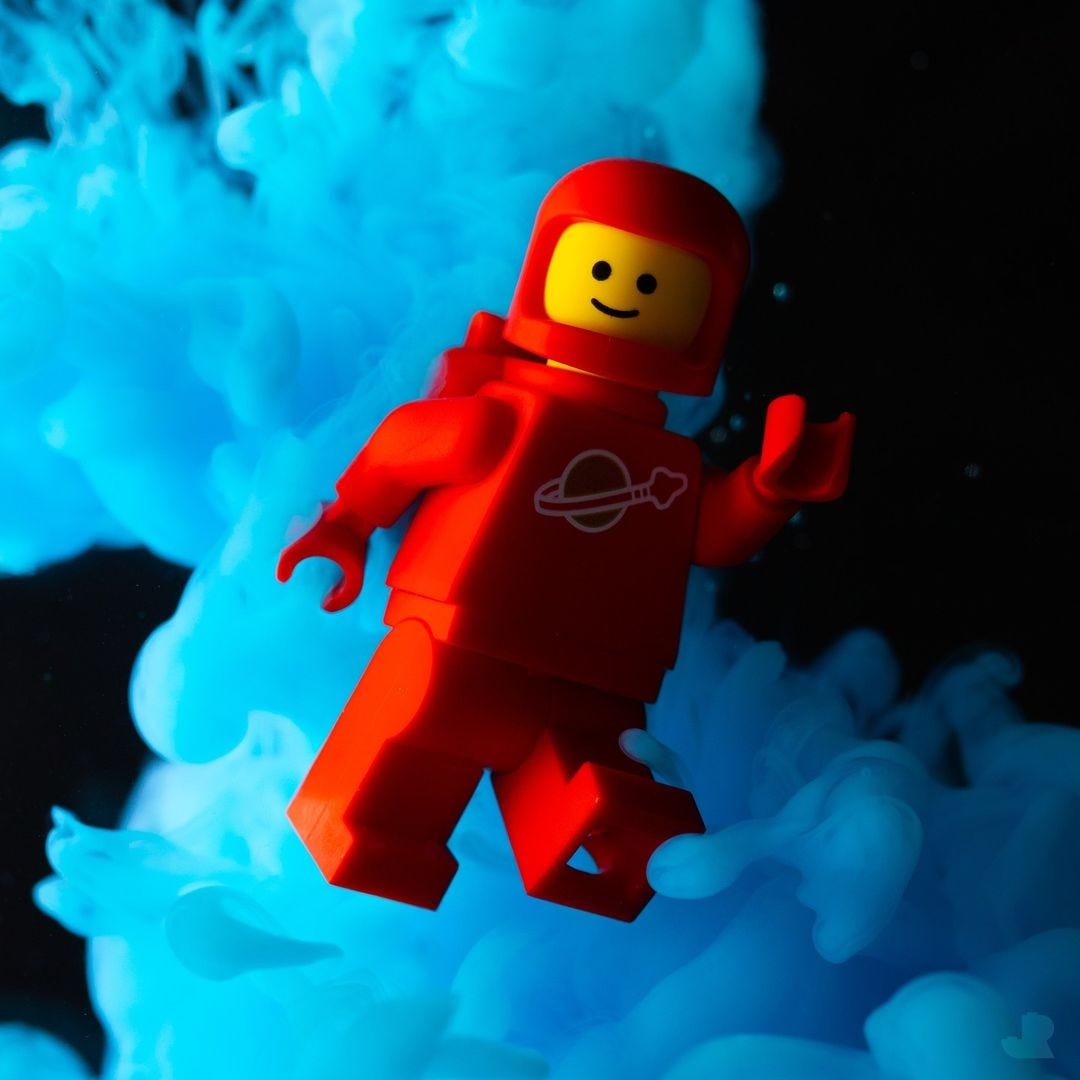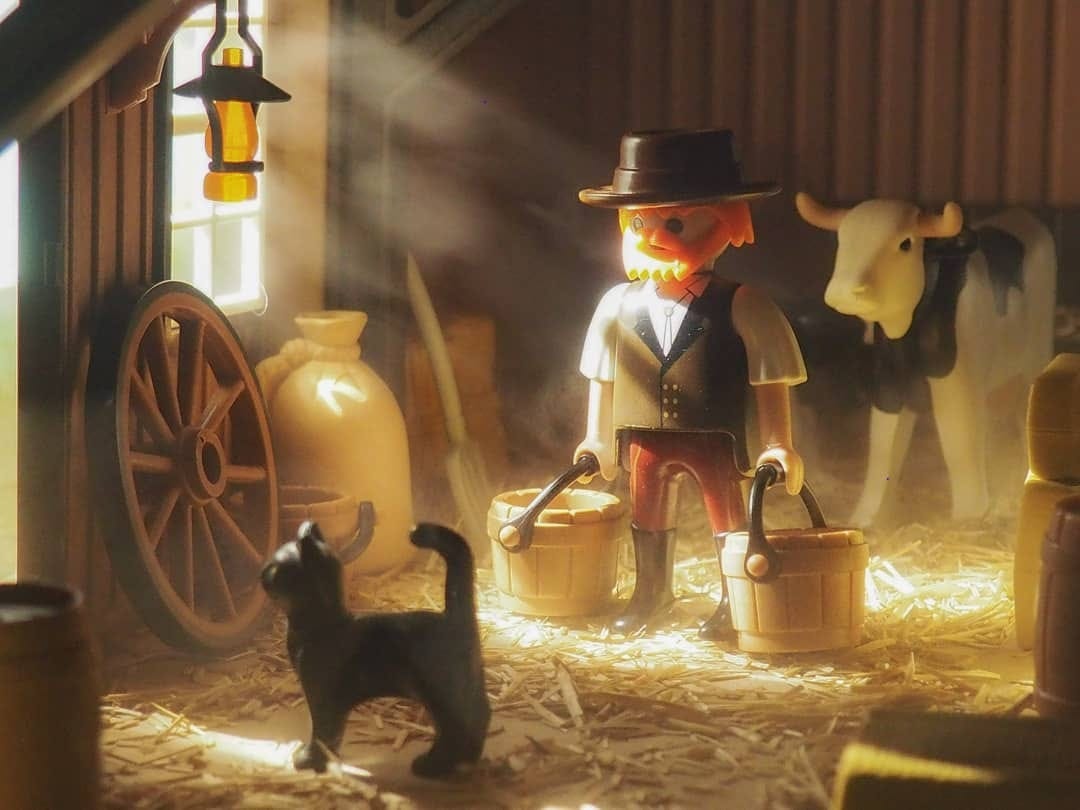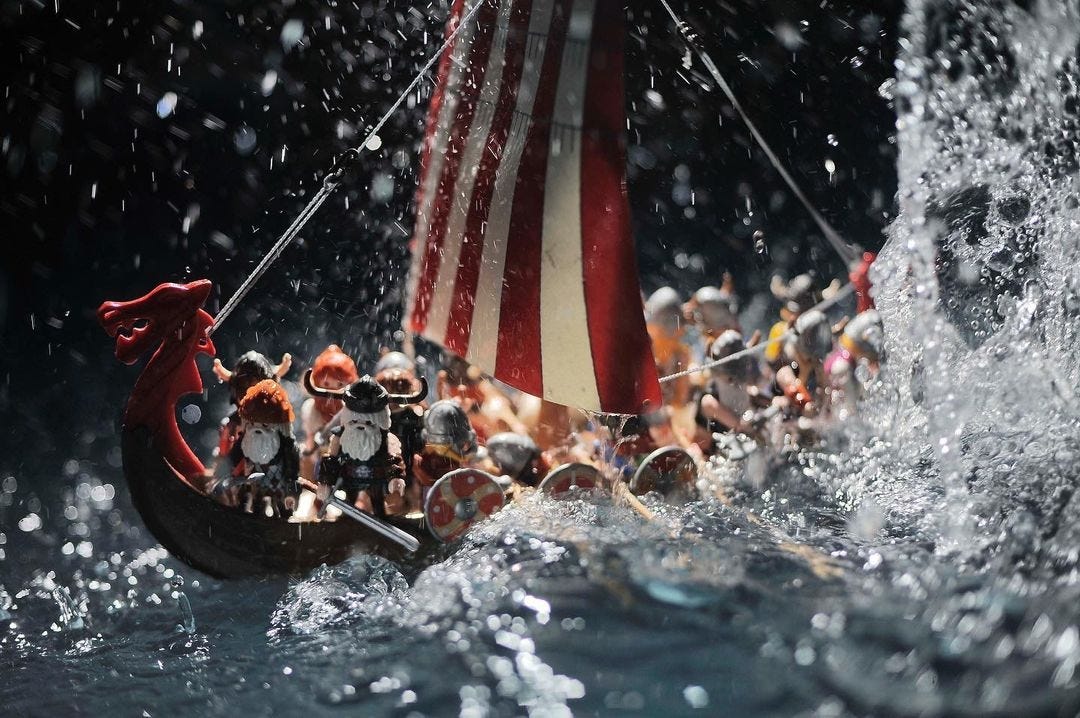Can you tell a story in a single photo?
Photographers as storytellers and why that's not me
There’s something that’s been gnawing at me for a while, and it’s this idea that photographers should be telling stories in every single photo.
In my previous newsletter, I wrote that I relate more to Garry Winogrand, an iconic American street photographer, when he said:
“I don’t have anything to say in any picture. My only interest in photography is to see what something looks like as a photograph. I have no preconceptions.”
I don’t have anything to say in my toy pictures either. My only interest is seeing LEGO toys as a photo.
Unlike Winogrand, though, who shot random encounters of people in public, I do have an idea about my character, the setting I want to put it in, the lighting, and the composition. In short, I have a preconception: my genre demands it all be staged.
Creating stories
A viking returns home and sees his kitten. A king is haunted by the undead. And then? Or rather, but and therefore? I don’t know.
I have concepts; but stories, I have none. I have no plot, no conflict, no resolution. There’s no sequence of events. I’m being pedantic here, highlighting the difference between a concept and a story, but having an interest in etymology makes me appreciate words and their definitions.
Concepts are just ideas, and of those, I have no shortage.
I did earnestly try coming up with stories as photo essays for a few months: thinking more deeply about who the subject is, what’s the environment, what’s happening in the scene, and what might happen next.
I made it a personal challenge to tell stories because who knows, it might turn out to be a more fun way to ideate, take more shots, or make my photos better.
It was a good exercise in exploring other processes: I even expanded the story-making into collaborations with other toy photographers which were fun.
But after my experiment, I concluded that “stories” aren’t very important to me and something I don’t want to incorporate into my workflow. I think creating a story is superfluous for my style of photography since I have a strong grasp of composition and lighting which, in addition to having an interesting character, carries most of my photos already.
Composition and lighting techniques can establish tones, moods, and atmosphere all of which can create emotions and elicit reactions in both the photographer and the viewer.
I believe that a successful photo is one that leaves you changed for having made it or seen it. By “changed” I mean you paused, you smiled, you thought, you felt fulfilled or proud, or you shifted into whatever new mood, state, or mindset.
In short, I’ve cut out the middle man– the story– and went straight for the emotion and reaction.
I want to underscore the photographer’s emotions and reactions matter in this process, not just the viewer’s.
I shoot primarily for the joy of creating a photo, not for others to look at it. I’ve touched on that before and I think I’ll write about it in the future because sharing hasn’t really been examined as part of the modern photography workflow but has a huge effect on us emotionally and mentally.
Different approaches
But just because creating a story didn’t work for me doesn’t mean it won’t work for anyone else.
Take a page from filmmakers or worldbuilders and use a story framework to create a great photo if it helps you visualize and execute.
After all, filmmakers also use principles of composition and lighting when making films. The Director of Photography (DP) or cinematographer in particular is the person tasked with taking the director’s vision and making the decisions on composition, lighting, gear as well as camera movements.
They use composition and light in a similar way painters from the classical arts through to the Renaissance used them to engage the viewer or provide a visually compelling scene. For filmmakers, composition and lighting are used to tell a story.
It’s here where I think people take the “storyteller” workflow from: the DP is in service to and support of the director, the person with the story which is paramount in their work.
So for these toy photographers who are more heavily influenced by cinema, their approach to creating a photo includes creating a story first and supporting that with composition and lighting.
Other toy photographers are excellent at coming up with concepts that are minimalist, using color and contrast to arrest my scrolling and make me smile– changing my state of being.
Or it might be an uncommon technique that grabs my attention and inspires me.
It’s usually a clear concept, good use of composition techniques, and purposeful lighting that makes me look at photos longer. I relate to these more probably because that’s what I’m interested in most. And my experience as a photographer gives me the vocabulary and knowledge to appreciate what I’m looking at which is really satisfying.
A Stretch
For me, a good photograph simply evokes an emotion or elicits a reaction. I’m after the changed state of being, mine or the viewer’s, but mostly mine. I make custom characters because it’s a thrill to see something entirely new in my hands, of my own doing. I experiment technically and creatively with photography because I want to stretch what I know and how I work. I’m always richer for it.
Am I a storyteller? No, I don’t even set out with a story in mind, just a concept.
Usually, my subjects have an accessory or a prop and I make sure they are looking at something other than the camera, but I don’t think doing those things qualifies my photos as stories.
I may use the same tools and techniques as filmmakers or other visual storytellers but that doesn’t make me one of them.
I think it’s a stretch of the imagination to say we can tell a story in a single photo. Even photojournalists who are charged with documenting developing stories can’t really do it without a headline, caption, or mass public awareness accompanying their photo.
Perhaps this is what some toy photographers are really asking of their audience though: to stretch their imaginations, to engage, to take what they’ve made, and create their own story.
Myself, I don’t tell stories. At least, I don’t think I do. I wonder now if others think so and I’m just being too prescriptive.
But anyway, if people want to infer a story from a concept I’ve created, they can go right ahead and enjoy that activity, possibly even share that thought with me. But I didn’t put a story there to begin with.
“I don’t have to have any storytelling responsibility to what I’m photographing. I have a responsibility to describe well.” - Garry Winogrand
Toy Photography Features
Starting TBTP has been such an eye-opener for me in so many ways, but probably one of the most inspiring of them was seeing what the Playmobil community creates.
LEGO minifigure photographers both whine about and embrace the 7 points of articulation, so it’s really amazing to see how Playmobil photographers manage with even less.










It's a very interesting problem, the question of stories. I'm a writer as well as an on-and-off photographer, so I've got a big part of me that wants to fill out stories around pieces, at least when I'm constructing something rather than just catching cool sights.
That said, I've also noticed a LOT of illustrators doing...well, the word that comes to mind is *scenes.* Not quite whole stories, but repeated windows into the lives and events around given characters. Building up these recurring casts who get seen again and again, never quite forming a beginning-middle-end but instead existing in an eternal Now. It feels like there might well be some inspiration that could be taken from that for work with recurring characters, especially in the realm of LEGO mini figs where design is so strong.
This is a really interesting article! Your statements make me reconsider my own point of view. Exciting! Let's see what comes out of it